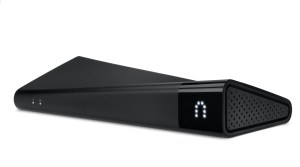Years ago, Sling Media introduced a new line of products that were truly revolutionary. By encoding TV into digital streams and then slinging them over the Internet, Sling changed the way viewers thought about TV. With a Slingbox, users could for the first time take live TV with them, anywhere they went. It was beautiful. It had so much promise.
Then Sling sold to EchoStar for a redonkulous amount of money, and the world moved on.
Broadcasters began putting their own clips online so that users no longer had to "sling" or steal them. Cable companies began producing their own apps for watching TV in other rooms of the house, so that people could watch the game while in the bathroom. ESPN began streaming its entire lineup of channels over the Internet to users who paid for cable. Suddenly, the need for a Slingbox seemed moot.
The company has been gradually iterating on its product, releasing mobile and tablet apps to complement its browser-based viewing. But its hardware stayed the same. And as a result, Sling never made it past the whole hobbyist market, selling mostly to people who buy gadgets for the sake of buying gadgets.
But behind the scenes, Sling has been working on something bigger — basically readying a whole new line of products to help users stream their favorite TV shows to their favorite devices. It's announcing today the Slingbox 500 and Slingbox 350, two brand new devices that have a lot of the same features as old Slingboxes — but with a few upgrades. For one thing, they can stream up to full 1080p HD video to all the same smartphones, tablets, laptops, and other connected devices supported by the older generation of Slingbox devices.
The new Slingboxes feature a new design aesthetic* that makes it unlike any other Slingbox before. Or really even any other box before. The Slingbox 500 (priced at $299) also has new features, like built-in WiFi and dual-band 2.4 GHz/5 GHz support. It also supports HDMI input and output, and allows users to stream media from their mobile devices to the Slingbox, through a new feature called "SlingProjecting." For now, that includes photos and videos, but could expand to other media types as time goes on. The 350 (priced at $179) is more or less a repackaging of the older Slingbox, at a slightly less expensive price.
Along with the launch of the new hardware products is the launch of new mobile apps for iPhone and Android. The apps sport a new universal user interface that will make navigating and watching content streamed from your Slingbox look more or less the same, whether on an iPhone or iPad or Android phone or tablet. It's also updated its website with the same look and feel, which has higher quality video and all that.
I got a Slingbox 500 unit and tested it out and also tried out the new apps and the new website, and they all work pretty much okay. They're limited to some extent by being connected to my Comcast set-top box and having to deal with the delay in switching channels or whatever else. I think the built-in guide in the apps is a huge improvement over searching for videos through the built-in set-top guide, but again, it's still at the mercy of my cable operator, which is always bad news. Having HD capability is great, but HD is kind of table stakes these days.
Unfortunately, that's about the best I can say about the new Slingbox, and that's a little sad. In 2004 it was a great idea, and even in 2008, at $300 a pop, Slingbox was a pretty interesting proposition for TV fans who wanted to watch TV on their laptop while traveling or anywhere else.
But in 2012? Today, there's a ton of streaming devices, apps, and content offerings out there for those who want to place-shift or watch things online, on tablets, or on connected TVs. It's difficult to recommend the fully blinged-out, WiFi- and HDMI-ready Slingbox 500 at $300. And it's also difficult to see the Slingbox 350 selling well at $180.
Sure, there will be hobbyists and gadget freaks who will be very excited about it, but those are the same people who buy the latest TiVo for $500. But considering the price and the availability of quality content across other platforms, it's a tough sell to make this mainstream. As disappointing as it might be to say about any revolutionary technology company, Sling's best day's are probably behind it.
==
* I guess you could call it that.


No hay comentarios:
Publicar un comentario